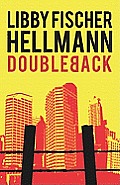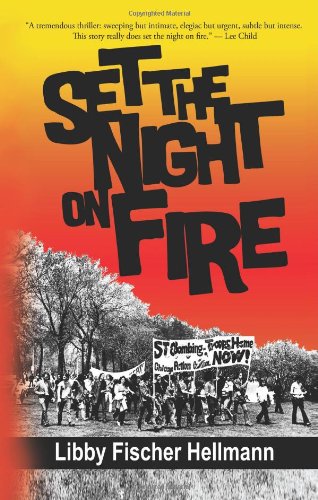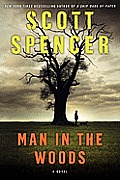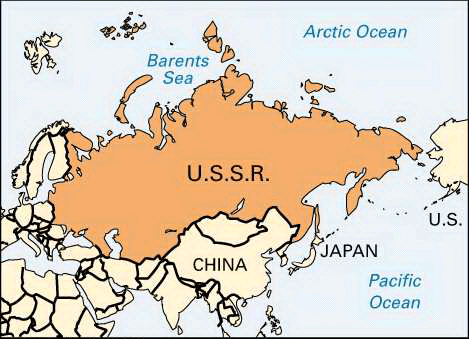 All of us here at Read Me Deadly are fans of Libby Fischer Hellman. We admire her two series: one featuring Ellie Foreman, a video documentarian (An Eye for Murder, A Picture of Guilt, An Image of Death, A Shot to Die For), and another with protagonist Georgia Davis, a police officer turned PI (Easy Innocence, Doubleback, Toxicity).
All of us here at Read Me Deadly are fans of Libby Fischer Hellman. We admire her two series: one featuring Ellie Foreman, a video documentarian (An Eye for Murder, A Picture of Guilt, An Image of Death, A Shot to Die For), and another with protagonist Georgia Davis, a police officer turned PI (Easy Innocence, Doubleback, Toxicity).We love the 2007 hardboiled crime-fiction anthology she edited, Chicago Blues. It's a top-notch collection of dark stories from twenty-one Chicago crime-fiction writers including Stuart Kaminsky, Barbara D'Amato, Sara Paretsky, Max Allan Collins, Michael Allen Dymmoch, Jack Fredrickson, David J. Walker, Marcus Sakey, Sean Chercover, Michael Black, J. A. Konrath, and Libby Fischer Hellmann. As Publishers Weekly says, "This impressive volume has soul, grit and plenty of high notes."
Last year, Libby riveted us with a standalone book called Set the Night on Fire, a thriller with a heart that showed us events from the tumultuous 1960s in Chicago and their reverberations in the present day, and an e-collection of her own short stories called Nice Girl Does Noir. This year, she's published both Toxicity, a prequel to the Georgia Davis series, and a novella called The Last Page that she wrote with David J. Walker. And, in addition to another book in her Georgia Davis series, she's working on two new standalones in her "Revolution Trilogy": The first, A Bitter Veil, will be out next year. In that book, an American girl falls in love with an Iranian student, moves to Tehran with him, and the revolution happens around them. The second is set in Cuba during the revolution.
Libby is a former national president of Sisters in Crime, a 3,400-plus member organization committed to strengthening the voice of female mystery writers. She has participated on judging panels for crime-fiction awards. She blogs with 10 other Chicago writers at The Outfit Collective and on her own website, Say the Word. Libby has also begun teaching a one-day, interactive workshop on how to write crime fiction.
When does she sleep?
We forgot to ask her that question in our interview, but we did manage to at least slow her down long enough to get her to answer a few of our other burning questions.
In one sentence, please describe what the writing process is like for you.
How about one word? Excruciating.
Really. I'm a very insecure writer. Which is why I am a master at procrastination. I would much prefer to answer interview questions rather than write. And when I do sit down to write, I'm my own worst enemy. I equivocate, revise, and edit dozens of times. I'd still be revising my first book if there hadn't been a deadline.
Your crime-fiction series books are very specifically set in Chicago's North Shore suburbs. Have you considered setting a mystery elsewhere?
I have and I did. In An Image of Death, my third novel, several chapters took place in Armenia and Soviet Georgia. In Doubleback Georgia went to Arizona and Wisconsin. In Set the Night on Fire, there were scenes in Wisconsin and Michigan. Then I really got brave and set my next release, A Bitter Veil, almost completely in Iran. And the book after that will be set largely in Cuba.
Over the years I've experimented much more – and widely – in my short stories. I have stories set in Pre-war Berlin, Texas, Washington, DC during the Fifties, and the West.
Do you see any evolution in your prose over the course of the books you've written? What have you learned about what to do and what not to do?
 No question. And you put your finger on it. It's not so much what to do, as what not to do. When you eliminate all the no-no's, you’re left with prose that often turns out to be rather straightforward. And that's the challenge. To turn that straightforward prose into memorable language, or language that immediately strikes a chord in the reader. Sounds so simple, but it usually eludes me. I love reading James Lee Burke for that reason. His prose is practically a prose poem and he inspires me. On the other hand, I love writers like Joe Lansdale and Val McDermid for the simplicity and punch of their prose.
No question. And you put your finger on it. It's not so much what to do, as what not to do. When you eliminate all the no-no's, you’re left with prose that often turns out to be rather straightforward. And that's the challenge. To turn that straightforward prose into memorable language, or language that immediately strikes a chord in the reader. Sounds so simple, but it usually eludes me. I love reading James Lee Burke for that reason. His prose is practically a prose poem and he inspires me. On the other hand, I love writers like Joe Lansdale and Val McDermid for the simplicity and punch of their prose.What nonfiction do you love to read?
Biographies and histories, with a large measure of politics thrown in.
Do you ever get burned out on reading crime-fiction novel after crime-fiction novel, just to keep up with what's going on in the market? What other styles of fiction do you love? What from those other genres do you incorporate in your crime fiction?
 I do have to switch it off for a while. Usually I'm reading nonfiction, but have been known to dabble in women's and contemporary fiction. Literary fiction less often.
I do have to switch it off for a while. Usually I'm reading nonfiction, but have been known to dabble in women's and contemporary fiction. Literary fiction less often.Did writing a research-heavy novel, like Set the Night on Fire, tempt you to do more historical fiction?
Actually, I think it was my short stories that tempted me. The very first short story I wrote was set in the 1930s in Chicago. I also wrote a story set in the 1930s in Berlin. That gave me the courage to try other times and other places. By the time I started Set the Night on Fire, I already was "knee-deep" in historicals, but recent historicals. You'll never see me writing anything that hasn't occurred from the 20th century on. Of course, I said I would never write any historicals at all, so you have every right to be skeptical.
Which of your books was the most enjoyable for you to write?
 Writing for me is NOT enjoyable. (See my answer to question #1). However, some are easier than others. I would say that Set the Night on Fire was pretty smooth sailing. A lot of it just flowed. Same with An Image of Death. I had a few moments of what I call "grace" writing those books, moments where the story was revealed to me, and all I had to do was follow directions. But that is rare. Usually it's a struggle.
Writing for me is NOT enjoyable. (See my answer to question #1). However, some are easier than others. I would say that Set the Night on Fire was pretty smooth sailing. A lot of it just flowed. Same with An Image of Death. I had a few moments of what I call "grace" writing those books, moments where the story was revealed to me, and all I had to do was follow directions. But that is rare. Usually it's a struggle.Could you tell us about your previous experience in the news and communications business? Any thoughts about the current state of journalism and image management?
Many years ago I worked in broadcast news: at PBS, NBC, all news radio, and I even worked for (don't shoot me) Roger Ailes, when he ran Joe Coors' news operation, TVN. Charlie Rose and Charlie Gibson were there too, btw.
The second part of your question is another of those I-could-rant-forever responses. The state of broadcast journalism today is reprehensible. I hate the 24-7 news cycle. It has had the opposite effect of what was intended… now nothing seems important. It's all drivel. As well as being manipulated and sanitized by its corporate owners. Print journalism isn't far behind. The only thing left is long form or investigative journalism, and that, too, is too infrequent. I can't stand to be yelled at, and that's pretty much what happens in cable news these days. I just turn it off.
Although it might sound like an oxymoron, I do believe in image management… to the extent that I believe everyone has the right to tell their side of the story. Even corporate interests. What I do not condone is active obfuscation and lying, which is pretty much de rigueur these days. I hate to bring up the "good ol' days" – makes me sound pretty ancient, but when I worked in PR (which I did for over 15 years), we did try to stick to the truth. Sure, we'd try to spin it to our client's advantage, but we didn't lie.
Last thing I’ll say… I love Twitter for news. Not only is it my favorite procrastination tool, but I have an entire list of "news" organizations I follow… I can get lost in the links for hours. When I do, I become the best informed person I know about any exotic, strange topic. At least for an hour.
 Please engage in a "what if" for a moment. You're not a writer, and your dream job has you doing what?
Please engage in a "what if" for a moment. You're not a writer, and your dream job has you doing what?Um… producing major motion pictures or beautiful independent films with Viggo Mortensen as the star. I love being in the editing room, btw. Even more than shooting on location.
When did you first start reading mysteries and which ones most grabbed you as a new crime-fiction reader?
I came relatively late to mysteries. I gravitated toward thrillers in my twenties, but after a steady diet of them, they all started to sound the same. World in jeopardy of blowing up, hero saves the world, walks off into sunset with woman. My mother, though, was and still is a prolific mystery reader, and one day, when I was complaining gave me a copy of Jeremiah Healy’s The Staked Goat. In a word, I loved it. (You can find out why here: http://therapsheet.blogspot.com/2009/11/book-you-have-to-read-staked-goat-by.html.) That started me down the road of reading mysteries. The rest, as they say, is history. Although I will admit to liking modern mysteries and suspense better than historical. Curious, since I'm writing historicals these days. But I am a World War II espionage junkie.
Blueberries for Sal when I was a little girl. Plink, plink.
Gone with the Wind when I was a teenager.
Catcher in the Rye also.
 You look beautifully pulled together in every picture I've seen of you. How much of your heroines' wardrobes match yours, and how much is different, and why. In general, do you think women authors are more conscious of costuming--and are more secure about detailing it--than male authors?
You look beautifully pulled together in every picture I've seen of you. How much of your heroines' wardrobes match yours, and how much is different, and why. In general, do you think women authors are more conscious of costuming--and are more secure about detailing it--than male authors?First off, thank you! Most of the time I wear sweats, so when I do get dressed, it's kind of fun. Hmm… my protagonists... Ellie dresses like me. She'd rather wear jeans or sweats but when she needs to, she can pull it together, but only because her best friend Susan, the epitome of good taste, is her wardrobe consultant. Georgia opts for a spare, bare bones style. She wears pants and blazers, thick sweaters, and jeans. I think she only has one dress and one suit.
And yes, I do think women have traditionally been more conscious of clothing. We all know that what you wear makes a statement about your character. But what's interesting is that men are beginning to do it too, especially with their female characters. I think that's a hoot. For example, Joe Konrath has a character named Libby Fischer in one or two of his books. He called me at one point to ask specifically what she would wear.
 I understand you're a major athletic talent. You won the coveted Worst Bowler trophy at the 1st Annual Bouchercon Bowling Tournament in St. Louis, Missouri, earlier this fall. How often have you been given a chance to brag about your prowess? Will you be defending your title next year? I'm afraid to ask about your practice regimen designed to decrease your bowling skills.
I understand you're a major athletic talent. You won the coveted Worst Bowler trophy at the 1st Annual Bouchercon Bowling Tournament in St. Louis, Missouri, earlier this fall. How often have you been given a chance to brag about your prowess? Will you be defending your title next year? I'm afraid to ask about your practice regimen designed to decrease your bowling skills.Ahh… I fully expect my athletic prowess will go down in the Guiness Book of World Records. It was quite a feat.
What comment from a fan has meant the most to you and why?
It didn't come from a fan. It came from a member of my writing group. I was reading the first chapter of my first Ellie book (An Eye for Murder) after having read two unpublishable books that featured two male cops. (Which was curious, since I was never a cop, and to my knowledge, a male either.) At any rate, we read aloud, and the room was so quiet when it was my turn that you could hear a pin drop. Usually the other group members were busy writing down their criticisms of my work. When I finished I looked around and everyone wore a semi-stunned expression, and the woman who'd been the hardest on me said, "That was wonderful! You found your voice!" That is still the biggest compliment anyone has given me.
 On your blog, Say the Word, you have some in-depth talk about traditional versus e-publishing. Bottom line, do you think the market for printed, 3-dimensional books is doomed, at least as anything other than luxury collectors' items?
On your blog, Say the Word, you have some in-depth talk about traditional versus e-publishing. Bottom line, do you think the market for printed, 3-dimensional books is doomed, at least as anything other than luxury collectors' items?Don't get me started… I'll never stop. No, I don't believe the book will just be a luxury item. It's really quite an efficient tool— portable, flexible, and relatively affordable. It makes no sense to me that we need to use a battery in order to read. In fact, I think the Big 4 (I think we'll lose a couple) are going to rally and ultimately control more of the ebook market than they do now, but they're going to have to move fast. I do think tablets are going to end up being the means by which we consume news and articles in the future, but books will always be around for lazy reads and stories.
 A comet is due to end the world tomorrow. Tonight is your last dinner, and a chef will cook anything for you and three other people, none of whom can be your family or friends. In fact, for this dinner, you can raise the dead. What will you ask the chef to serve? Who will be your dining companions?
A comet is due to end the world tomorrow. Tonight is your last dinner, and a chef will cook anything for you and three other people, none of whom can be your family or friends. In fact, for this dinner, you can raise the dead. What will you ask the chef to serve? Who will be your dining companions?Viggo Mortensen. If he comes, I won't need anyone else.
 The chef will sauté soft shell crabs, and whatever else he or she wants. Actually, I'd like to ask Abbie Hoffman if he thought he was for real. And I'd like to ask Harper Lee if Truman Capote wrote To Kill a Mockingbird and that's why she never wrote anything else. Oh, and I wouldn't mind having George Harrison jam with Dylan and Clapton after dinner. But Viggo is the only one I NEED to have.
The chef will sauté soft shell crabs, and whatever else he or she wants. Actually, I'd like to ask Abbie Hoffman if he thought he was for real. And I'd like to ask Harper Lee if Truman Capote wrote To Kill a Mockingbird and that's why she never wrote anything else. Oh, and I wouldn't mind having George Harrison jam with Dylan and Clapton after dinner. But Viggo is the only one I NEED to have.Please tell us about a guilty pleasure.
Playing hooky and going to the movies in the middle of the day.
Think fast and say the very first thing you think of.
I hate this song:
These Boots Are Made for Walking (Nancy Sinatra).
I love this movie:
The Godfather, 1 and 2.
 My nightmare vacation would be spent in:
My nightmare vacation would be spent in:Washington DC in August.
Give me $100 and two hours and you'll find me at:
Nordstrom’s.
A "tchakabiskabockabob" is:
the same thing as a thingamajig in Russian.
Are you the sort of person who can't remember a joke to save your life or do you have one to share with us?
I'm a horrible joke teller. I forget every punch line. There's only one joke I do well, and it's a visual thing. (My daughter cracks up every time.) If you're lucky, maybe I'll make a video of it one day.
A must for a Chicagoan: Cubs or White Sox?
Cubs, Cubs, worthless Cubs…
Thanks, Libby.
By visiting her website, you can learn more about Libby Fischer Hellmann and her writing.









































